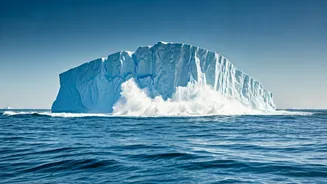Unforeseen Detonation
The scientific community was taken aback when they witnessed the remarkably quick disintegration of the Antarctic glacier. The speed at which it occurred
far surpassed any prior predictions, presenting an alarming view of the potential consequences of climate change. The unexpected nature of this event has spurred an urgent reassessment of existing models and methodologies used to anticipate the future behavior of glaciers. The incident provided solid evidence of the accelerated melting of ice sheets, which further complicates the already dire predictions associated with global warming. Scientists are working continuously to examine the contributing variables, including rising temperatures and possible instability within the glacier itself. Understanding the nuances of this rapid collapse will be vital for improving predictions about future sea-level rise and the associated impacts on coastal regions.
Global Sea Level Impact
The sudden collapse of this Antarctic glacier has immediately raised concerns regarding global sea levels. As vast amounts of ice melt and flow into the ocean, the volume of water rises, thereby threatening low-lying coastal areas and island nations with inundation. Scientific models forecast that accelerated melting from glaciers can lead to more frequent and intense coastal flooding, causing displacement of communities and infrastructure damage. The increase in sea level presents a wide array of secondary challenges, including saltwater intrusion into freshwater sources, which can disrupt ecosystems and water supplies. Researchers are intently focused on precisely measuring the contribution of this glacier's collapse to overall sea-level rise and refining their projections to account for further changes in the Antarctic ice sheet. The magnitude of the incident highlights the immediate and far-reaching consequences of climate change on a planetary scale, demanding global collaborative action.
Driving Factors: Warming
The key driving force behind the glacier's rapid collapse is attributed to the ongoing warming of the planet. Rising global temperatures have caused air and ocean temperatures to rise, leading to accelerated melting rates for ice formations. As warmer water encroaches upon the base of glaciers, it facilitates melting from underneath, which destabilizes these massive ice structures. Increased surface temperatures, including the impact of stronger solar radiation, directly contribute to the melting process from above, further weakening the glaciers' integrity. Scientists point out that even seemingly minor increases in average temperatures have significant effects on polar regions. The feedback loops involved, like the albedo effect, mean that the melting of ice reduces the reflectivity of the surface, which leads to more absorption of solar energy and hence more warming. The study of these intricate interactions is critical for improving climate models and foreseeing future climate scenarios, particularly in regions sensitive to climate change.
Ongoing Research Efforts
In the face of this alarming development, scientists have intensified their research efforts, employing a variety of sophisticated techniques to better understand the dynamics of the collapsing glacier. They use satellite imagery and advanced radar systems to monitor the glacier's movements and measure changes in ice thickness. Sophisticated computer models, driven by observational data, are then built to simulate the complex interactions within the glacier system and predict its future behavior. Data collection from the field is crucial; this includes ice core samples that provide valuable insight into the history of climate conditions and glacier stability. The findings from these investigations are critically analyzed to build more comprehensive climate models and predictions. This multi-faceted approach, integrating observation, simulation, and fieldwork, is integral in furthering our knowledge of these critical systems, giving us the insights required to make informed decisions.
Long-term Implications
The repercussions of the Antarctic glacier's rapid collapse extend far beyond the immediate increase in sea levels. Ecosystems are susceptible to substantial alteration as rising sea levels alter coastal habitats, thus creating displacement, while the rise of sea temperatures has repercussions for marine life. The collapse offers a glimpse into how rapidly irreversible environmental changes can unfold. The potential for the release of vast amounts of methane and carbon dioxide from thawing permafrost, and also from the glacial ice, is another frightening aspect. These greenhouse gases could trigger further warming, thereby compounding the existing climate crisis. As a result, the rapid breakdown of the glacier underscores the significance of international collaboration and the prompt implementation of mitigation and adaptation plans. These involve reducing greenhouse gas emissions and strengthening infrastructure in readiness for the changes already underway.
Future Considerations
To address the challenges posed by this dramatic event, significant changes in global policies and practices are required. International agreements, such as the Paris Agreement, must be strengthened and upheld to limit greenhouse gas emissions. Transitions to renewable energy sources, energy efficiency improvements, and the conservation of natural resources, will all play key roles in climate mitigation. Further research into the stability of other Antarctic glaciers is paramount, to better understand potential risks. Infrastructure projects, involving seawalls, improved drainage, and coastal protection, need to be developed in vulnerable areas to protect communities from the imminent effects of rising sea levels. Promoting environmental consciousness and empowering communities to become more resilient in the face of environmental disasters is essential. The future depends on global commitment and decisive action.











